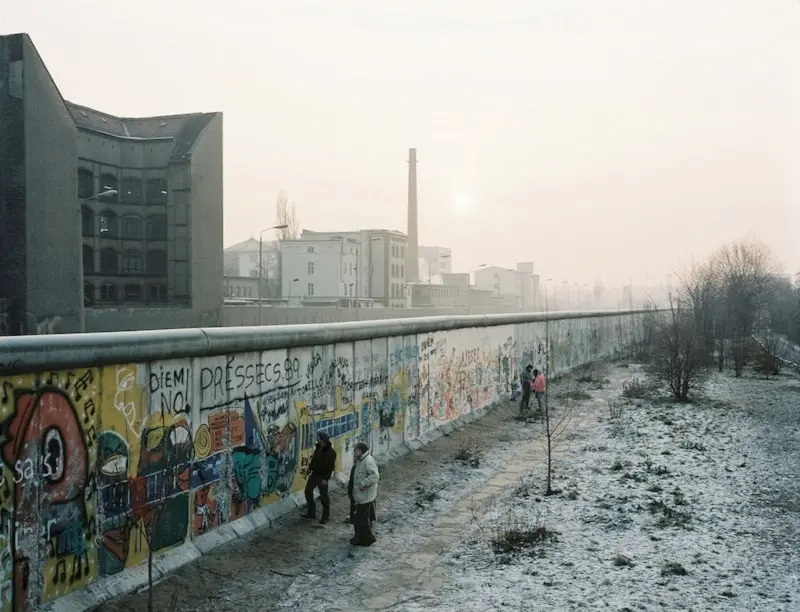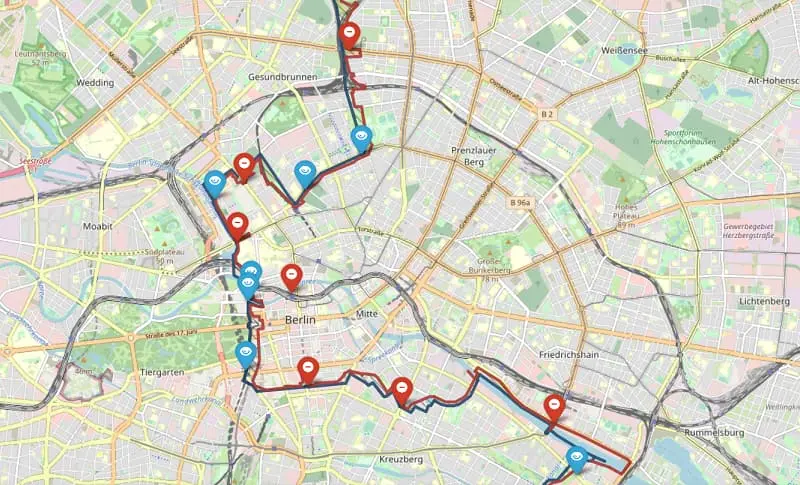The Berlin Wall was built by the Soviet government after the end of World War II and the division of this city into two parts, East and West.
The Berlin Wall is one of the most famous historical monuments in the world. This wall, which was built by the Soviet government in order to prevent citizens from leaving East Germany to West Germany, became known as the "Iron Curtain" and a symbol of the Cold War. This wall collapsed after 28 years of repression and murder of those who tried to escape to the other side. There are small parts of the Berlin Wall left to keep the memory of the dead alive; A part that is considered one of the sights of Berlin today.
Where is the Berlin Wall?

Between 1961 and 1989, the Berlin Wall was 155 kilometers long in the city of Berlin, the capital of Germany. This wall is from "Bornholmer", "Chaussee", "Invaliden", "Friedrich", "Prinzen", "Sonnen", "Waltersdorf" streets. "Waltersdorf chaussee" and passed by the "Oberbaumbruecke" bridge.
After the fall of the Berlin Wall in November 1989, only small parts of it remain in some neighborhoods of the city, reminding the German people of the events that took place over the course of 28 years. Today, to see the Berlin Wall, you can visit the following monuments:
East Side Gallery: The longest surviving part of the Berlin Wall is approximately 1.3 kilometers long and is located near the Oberboom Bridge. The reason for this name is the famous paintings that have been drawn on it; The graffiti, executed by international artists, contain political messages and symbols of peace, making this part of the Berlin Wall famous as the "world's largest open-air gallery". To visit this attraction, just take yourself to the subway station "Ostbahnhof" on the S-Bahn line.
Berlin Wall Memorial: In this open-air museum, you can experience walking on the border between East and West Germany; A place that used to be known as the "Death Range". In this attraction, a guard tower, the route of the escape tunnel of the people of Berlin and pictures of the dead are displayed. The most convenient access route to visit this attraction is the "Bernauer Strasse" subway station on the U-Bahn line.

Topography of Terror: This museum used to be a prison and Gestapo headquarters and is also known as "Gestapo Museum". The outdoor part of this museum displays a part of the Berlin Wall, and the building of this museum is dedicated to presenting images and documents related to the terrible crimes of the SS forces and the secret police of the Nazi regime. To visit this attraction, go to the subway station "Kochstrasse" on the U-Bahn line.
Potsdamer Platz subway station: This neighborhood is one of the last places where the Berlin Wall was (physically) destroyed; However, 6 blocks of the wall have been memorialized in front of the entrance of this metro station, and the signs installed on them provide visitors with information about the history of the wall. Potsdamer Platz subway station is accessible from both U-Bahn and S-Bahn lines.
Pavement of the Berlin Wall in the city: To show the exact location of the Berlin Wall, a continuous pavement has been stretched in two rows all over the city. Some parts of this cobblestone are accompanied by a copper plate with the following words on it:
The Berlin Wall 1961-1989
If you are passing through the central parts of the city, you will definitely pass the "wall path".
Why and how was the Berlin Wall built?

With the end of the Second World War in 1945 and the defeat of Germany, the Allies divided the country into two eastern and western parts to determine its fate; The western part was called the "Federal Republic of Germany" and was a non-independent and democratic country under the control of the British, French and Americans. East Germany was handed over to the Soviet Union under the name "German Democratic Republic" and had a socialist government.
Berlin, the former capital of Hitler's regime, was completely located in East Germany and, like the entire country, was divided into two parts, East and West. In the first decade after the war, there was no wall separating East and West Berlin, and there was no clear border for these two parts; Public transportation was running between the two parts of the city, citizens could move freely, and only East and West Berlin had a distinct currency; But over time, the economic situation of the Federal Republic of Germany made significant progress; While the economy of East Germany was declining. Outside the city of Berlin, the difference between East and West Germany increased significantly; In West Germany, freedom of speech, freedom of the press and economic miracle stood out.

A decade after the division of Germany, the wave of migration from East to West Germany was so widespread that the German Democratic Republic reached the point of collapse, and the losses caused by labor force migration worsened the economic situation of East Germany. From 1949 to 1961, about 2.5 million people migrated from East Germany to the West of this country. Since America was one of the three countries supporting West Germany and due to the Cold War between the Soviet Union and the United States, the flood of immigration was a source of embarrassment for the Soviet Union and prompted this government to impose restrictions on the departure of its citizens from East Germany.
The strictures gradually increased; East German citizens were no longer allowed to leave easily, and the borders were protected more than before. However, West Berlin was still the only escape route from the suffocating rule of Khrushchev. On August 13, 1961, the passageway was closed without prior notice by the military and the eastern and western sections were separated by barbed wire. This border was fortified over the following years with walls, barbed wire, and landmines and traps; A wall with a height of four meters and a length of 155 kilometers, which became known as the Berlin Wall.
When was the Berlin Wall built?

After the Soviet government took control of the eastern part of Berlin, the economic situation and social freedoms worsened and caused the massive migration of people living in this city from east to west. This action of the citizens of East Berlin caused extensive damage to the Soviet Union and put East Germany on the verge of economic collapse.
By the order of Khrushchev, the Soviet leader, all communication routes between East and West Berlin were blocked, and on the morning of August 13, 1961, after the East German soldiers surrounded the street leading to the border points, the workers started building the famous Berlin Wall; to become a roadblock for fugitives. It took only two weeks to build a concrete wall with barbed wire. Before the construction of the wall, the residents of Berlin traveled freely in the east and west of the city for daily affairs, work, recreation and shopping.
After the Berlin Wall was built, three border crossings were built to control traffic, the most famous of which was Checkpoint Charlie (Checkpoint C); A crossing that only diplomats had the right to cross and over time became a famous symbol of the city's division. The Berlin Wall greatly reduced the tensions between the parties of the Cold War; To the extent that "John F. Kennedy also admitted that "a wall is better than a war".

It was not impossible to escape from East Berlin to West Berlin. In the 28 years of the Berlin Wall, 5,000 citizens of East Berlin, including 600 border guards, managed to escape. Escapers made their way to West Berlin by jumping over barbed wire, crawling through sewers, flying in balloons, and crashing their cars into unstable parts of the wall. During the years when the wall was erected, more than 140 people lost their lives trying to escape from East Berlin to West Berlin.
How and when was the Berlin Wall destroyed?

In the 1980s, the Soviet Union gradually lost its control over the Soviet Union. The Soviet Union retreated from many of its policies during this decade. When Hungary opened its borders in 1989 and the way was opened for East German residents to enter the Western world, the border between the two Germanys lost its meaning.
Finally, with the beginning of nationwide demonstrations in East Germany against the communist regime, the authorities of the German Democratic Republic announced that the border between East and West would disappear. This news brought so much excitement to the residents of the East that a large crowd of people went to the West through the checkpoints, where they were welcomed by the Westerners.
The people who did not even have the right to approach the Berlin Wall for 28 years and hundreds of people were killed trying to escape to the other side of this wall, started to destroy this wall little by little with their suppressed anger. In two days, more than two million people entered West Berlin. A journalist referred to this event as "the biggest street party in the history of the world". One year after the fall of the Berlin Wall, on October 3, 1990, the reunification of East and West Germany became official.
Berlin Wall Memorial

More than 30 years have passed since the fall of the Berlin Wall; But the historical background and social effects of this phenomenon have kept it at the top of Berlin's sights. The two rows of cobblestones that stretch across the city center are a reminder of where the Berlin Wall once stood; Notice boards and monuments are also dedicated to explaining the history of the wall in the corners of the central parts of the city.
Today, most parts of the wall have been completely recovered from the city surface; But parts of it have been preserved in the urban landscape in order to keep alive the memory of the hard times and to honor those killed at that time. The East Side Gallery, with its 1.3 km length and famous murals, can be considered the most visited monument of the Berlin Wall.
Other parts of the Berlin Wall memorial can be seen at the Berlin Wall Memorial Museum, the Topography of Terror Museum, and the entrance to the Potsdamer Platz subway station.

Checkpoint Charlie, also known as Checkpoint Charlie or Checkpoint C, is another monument of the Berlin Wall located on Friedrichstrasse. This checkpoint was the most important passage between East and West Germany, for diplomats, which is still preserved today in the middle of this street. Adjacent to this checkpoint is the Berlin Wall Memorial Museum, where pictures and objects related to the history of this place are displayed.
The Berlin Wall movie

Share your views and information about the Berlin Wall with Eugene Gosht. Frequently asked questions
What year was the Berlin Wall built?
1961
What was the reason for the construction of the Berlin Wall?
Preventing mass migration of East German residents to West Germany
In what year did the Berlin Wall fall?
1989
What was the reason for the migration of Easterners to West Germany?
Better economic situation and more freedoms in West Germany
